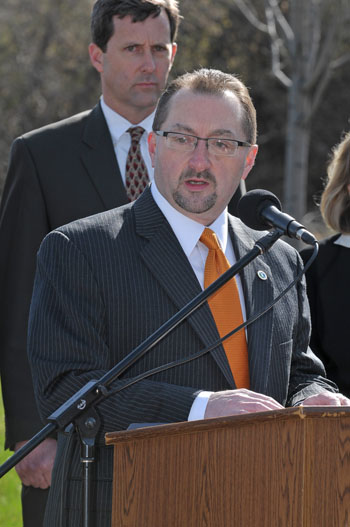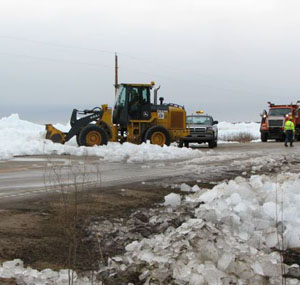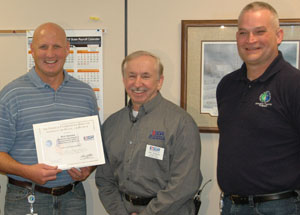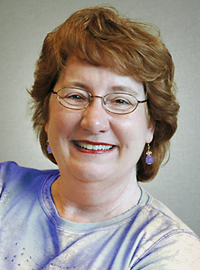 |
|

|
 |
TABLE of CONTENTS
 |
Hwy 169/I-494 interchange, I-35 project in Duluth top 2010 state road construction program |

Commissioner Tom Sorel emphasized safety and innovation in his remarks April 7 announcing the 2010 construction season program. Photo by David Gonzalez |
The governor and top state transportation officials announced a $1.3 billion state construction program for 2010 on April 7.
“Minnesota’s transportation system is a cornerstone to a strong and vibrant state economy,” Gov. Pawlenty said at a news conference near the Hwy 169/Interstate 494 interchange in Eden Prairie, site of one of the big projects scheduled to begin later this year.
“Our administration has invested more than $5 billion on more than 1,900 projects since 2003 to battle congestion, improve safety and foster economic growth,” he said.
A second news conference was held later in the day in Duluth, where crews will begin a two-year, $70-million project to replace and repair bridge and pavement on I-35.
Of this year’s 283 projects, 217 are state highway construction projects; the other 66 projects improve safety at railroad crossings, repair seawalls and docks in three ports, make improvements on runways and terminals at regional airports, and remodel or construct new transit facilities.
“Mn/DOT is focused on improving our highways and maximizing the capacity of the system," said Commissioner Tom Sorel.
Projects in the Twin Cities area include:
- Converting Hwy 169 at I-494 to a freeway to improve traffic flow and reduce congestion in Bloomington, Eden Prairie and Edina ($150 million)
- Rebuilding the Hwy 52 Lafayette Bridge in St. Paul ($185 million)
- Constructing a new interchange at Hwy 101 and Hwy 13 in Savage ($20 million)
- Resurfacing I-94 from Western Avenue to Hwy 280 in St. Paul ($11.05 million)
Projects in northern and central Minnesota include:
- Reconstructing, resurfacing and building Hwy 61 from Duluth to Grand Portage to improve safety ($13.7 million)
- Expanding Hwy 71 from two to four lanes, adding turn lanes south of Bemidji and building a new bridge over Hwy 2 ($13.5 million)
- Constructing roundabout, reconstructing Hwy 95 and Mille Lacs County Road 29 bridges ($2.7 million)
- Reconstructing Hwy 25 in Pierz and installing sidewalks, curbs, gutters, sewers, utilities and street lights ($2.6 million)
- Reconstructing Mississippi River bridges on Hwy 10 bypass in Little Falls-damaged during spring 2010 flooding ($1.5 million)
Projects in southern Minnesota include:
- Building a four-lane alignment and 10 bridges on Hwy 14 south of Waseca ($56 million)
- Constructing a four-lane divided highway bypass, building bridges and installing lighting on Hwy 23 near Paynesville ($32 million)
- Build a highway interchange and frontage road on Hwy 52 near Pine Island in Olmsted and Goodhue counties ($30 million)
- Constructing a four-lane road on Hwy 59/ Hwy 60 to Nobles County Road 4 in Worthington to improve safety and mobility ($23 million)
- Replacing railroad tracks, building turnouts, resurfacing grade crossings and installing grade crossing safety equipment in Sibley County ($7 million)
- Resurfacing Hwy 60 from Worthington to Wilder. The project will use a warm-mix asphalt that saves energy ($6.2 million)
For a complete list of projects, including construction dates and traffic impacts, visit the Web site at www.mndot.gov. |
 |
|

|
 |
TABLE of CONTENTS
 |
Mn/DOT’s online community connects with public, seeks input |
By Lisa Yang
Six hundred Minnesota residents were invited to participate in Mn/DOT’s first online community forum on March 24 to begin an open dialogue that will help the department better understand its customers’ transportation-related needs, issues and expectations.
“The online environment allows us to meet the customers where they’re at and interact with us when it fits their schedules,” said Karla Rains, statewide market research manager. “With this online community, Mn/DOT can ask a question and have an answer within days if needed.”
Participants were asked several questions regarding what they thought of Mn/DOT and a few of its programs. Some participants have already started their own discussions about roundabouts, talking on a cell phone while driving, reversible lanes, fast drivers in the slow lane and slow drivers in the fast lane.
“Over time, the online community lets Mn/DOT learn how citizens experience transportation changes and improvements, especially through the change of seasons and as they occur, such as snow plowing and road construction,” Rains said.
Participants will contribute to the online community for about a year. Their interactions will consist of filling out surveys, uploading photos to the photo gallery and partaking in live online chats. The forum will be open around-the-clock.
“The online community is another tool for connecting with our customers. It will be used to supplement our traditional research methods, not replace them,” Rains said.
One in five households have eliminated their landlines altogether while 74 percent of Americans over the age of 18 are on the Internet, according to Rains.
“We need to continually re-evaluate how we reach our customers by modifying and supplementing our research methods to reflect our changing customers and changing technology,” Rains said.
Participants were selected to demographically reflect Minnesota’s population by way of age, income, gender, ethnicity and geographical area. The group is also balanced when it comes to the Metro area level and district level.
The online community will be managed by Mn/DOT and Communispace, a firm specializing in creating and managing online communities for customer feedback purposes.
Results from the community will be compiled and summarized into reports and shared on a monthly basis.
Privacy of the community forum is necessary so the department can maintain a reasonably close representative audience, according to Rains. It also allows members to interact with each other and with the facilitation team in a safe environment designed to foster trust, openness and candor.
“Through the online interactions, participants will serve as advisors to Mn/DOT by sharing their perspectives and opinions on a variety of transportation-related issues,” Rains said.
Employees with questions about the online community can contact Karla Rains. |
 |
|

|
 |
TABLE of CONTENTS
 |
Moving ice closes Hwy 1 along Lower Red Lake |

Steve Ufford and Rob Koisti, Northome truck station, work to clear ice from Hwy 1. Photo by Karen Bedeau |
Lower Red Lake is a 152,000-acre sheet of ice in the winter time. Those who live near the lake say you can hear the ice cracking at night when all else is still. How and where that ice breaks up, moves and melts depends on the weather.
On April 2, the ice methodically made its way onto Hwy 1, prompting maintenance workers from the Red Lake Reservation to request help from Mn/DOT.
“It’s hard to predict when the ice will start moving up and over Hwy 1 – it doesn’t happen every year,” said Karen Bedeau, District 2 public affairs coordinator. “This year’s event was small compared to the twenty-foot wall of ice that motorists encountered some twenty years ago.”
The maintenance crew from the District 2 truck station at Northome responded to the 8 a.m. call from the reservation and drove 45 miles to provide assistance. The Northome crew stayed throughout the afternoon to monitor the situation as huge piles of ice pushed through the trees toward Hwy 1. When the winds finally shifted, the danger of more ice over the highway passed. |
 |
|

|
 |
TABLE of CONTENTS
 |
Mn/DOT introduces telework pilot |
|
By Bob Filipczak
Mn/DOT launched a new telework initiative called eWorkPlace on April 1 that aims to:
- Improve employee morale
 Reduce traffic congestion Reduce traffic congestion- Reduce pollution
- Reduce gas consumption
- Help the department become an employer of choice for employees seeking flexibility
All employees interested in a telework option have until April 30 to apply. The application itself will help employees decide whether they are eligible. There is no limit on how many employees can participate in the pilot.
The pilot will last three months and then employees can talk to their supervisors about extending the arrangement. This pilot is also open to employees currently teleworking if they and their supervisor agree to increase the number of days they telework.
“I’m really excited to roll out the eWorkPlace pilot – it has great potential for how Mn/DOT accomplishes its work,” said Karin van Dyck, labor relations manager. “It may take some time to shift our culture, but it’s really where the world of work is heading.”
eWorkPlace is a project sponsored by Mn/DOT and the University of Minnesota's Humphrey Institute to encourage all employers to consider telework for their employees.
“Telework makes sense on so many levels and hits so many of our strategic goals for the organization,” said Commissioner Tom Sorel. “This pilot puts us among the leading Minnesota employers in terms of flexibility and innovation.”
The program will include resources for participants and supervisors on the eWorkPlace Web site. Teleworkers who are accepted into the pilot will be contacted with instructions about registering on eWorkPlace.
A one percent increase in the number of Minnesota workers who telecommute would mean:
- 25,000 fewer commute trips on the road every day
- 972,000 less vehicle miles traveled per week
- 390,000 less pounds of CO2 emitted daily
- 24,300 less hours spent commuting every week
- $1,170 average annual savings in gas and vehicle upkeep per teleworker
Source: http://www.eworkplace-mn.com/ |
|
 |
|

|
 |
TABLE of CONTENTS
 |
Mn/DOT employee eligible for vacation donation |
Brad Scott, District 2 Business manager, is now eligible for the state vacation donation program, which allows employees to donate up to 40 hours of vacation per fiscal year for approved recipients who have exhausted their sick and vacation leave due to illness.
Scott’s nine-year-old daughter Sydney was recently diagnosed with a Germinoma, a type of pediatric cancerous brain tumor. Sydney will require chemotherapy, radiation and possibly surgery. Her treatment may require four to six months to complete. Sydney is also autistic, which makes treatment of the life-threatening tumor more challenging.
To donate vacation hours, go to the Employee Self Service Web site and click “Other Payroll” and then “Leave Donations.” The site also allows employees to view a list of all state employees eligible for the program and enroll as a recipient.
Related information:
Vacation donation: a worthy program for worthy people (Newsline, June 21, 2006)—Read a viewpoint from one Mn/DOT recipient.
|
 |
|

|
 |
TABLE of CONTENTS
 |
New video highlights resources available to military families |

Jim Sullivan, executive director of Minnesota’s Employer Support of the Guard and Reserve organization (center), and Andy Kubista, driving simulator program manager with Mn/DOT’s Office of Maintenance (right), present Rick Shomion, employee development supervisor (left), with a certificate naming him a patriotic employer.
Kubista, who serves as a staff sergeant in the Minnesota Army National Guard’s 257th Military Police Company, wanted to honor Shomion, his supervisor, for supporting his military duty during extended training times.
“Rick understands what my commitment to the Guard means to me and why I do it, and he has shouldered the additional tasks of running the simulator program in my absence,” said Kubista.
ESGR promotes cooperation and understanding between National Guard and Reserve members and their civilian employers. For more information, visit www.esgr.org. Photo by Nick Carpenter |
A pair of Mn/DOT employees recently produced a DVD training presentation that outlines the various resources available to employees who have family serving in the military or are military members themselves.
"We wanted employees with ties to the military to know that we understand we all serve when our loved ones are serving in uniform,” said Eric Davis, Human Resources director. “I asked HR project manager and 20-year Army National Guard Veteran Lucy Kender to help get the word out. She enlisted the support of video production specialist and U.S. Navy veteran Gary Andrist to produce a video entitled We All Serve Fort Minnesota.”
The 22-minute video presentation covers the military aspects of the Family and Medical Leave Act; the Beyond the Yellow Ribbon Program; the Employer Support of the Guard and Reserve organization and the Uniformed Services Employment and Reemployment Rights Act of 1994.
The presentation also includes portraits of two current employees—one whose son is on duty in Iraq and one who is a member of the Minnesota National Guard.
“Whether you are a member of the military or the family member of someone in the military, we want you to know and understand your rights and responsibilities as a state employee with military affiliation,” Davis said.
Although the target audience for this presentation is military family members, the video holds valuable information for everyone.
“Perhaps you have neighbors or friends who are part of a military family, this video can help you help them when needed,” Davis added.
The presentation’s title, We All Serve Fort Minnesota, builds on the concept that although Minnesota has no active duty military installations, all Minnesotans can offer support to military families, according to Davis.
For more information on military family resources, visit http://ihub/hr/military.
Employees interested in copies of the DVD presentation can contact Lucy Kender. For ease of viewing the video at home or any other non-Mn/DOT computer, the presentation is available at http://www.youtube.com/watch?v=8sIqeUUPSjI. |
 |
|

|
 |
TABLE of CONTENTS
 |
Help a military family if you can; new DVD outlines how |
By Lucy Kender, Human Resources

Lucy Kender, Human Resources. Photo by Colleen Anfang |
When I joined the Minnesota Army National Guard in 1976, our nation was still reeling in the aftermath of the Vietnam War. Support for military members and their families was tenuous—I often felt awkward wearing my U.S. Army uniform in public.
How times change. Happily, strong support for service men and women and their families now exists. Sadly, that support stems from our nation’s current involvement in war. Trust me, no one dreads war more than a soldier!
So, when I was assigned to produce a training presentation for Mn/DOT military families, I felt honored and thrilled—honored to provide a service to Mn/DOT military families and service members and thrilled to combine skills from my entire career (military, communications and human resources). It turned out to be a labor of love for me.
Fortunately, I got to work with my teammate Gary Andrist, Mn/DOT’s video producer on this project. Gary and I previously served together in the National Guard. Gary, an award-winning video producer, also served in the U.S. Navy, so he understands firsthand the importance of this topic to military families.
Here’s how it all started. Last year, Eric Davis, Mn/DOT’s Human Resources director, and I attended a briefing sponsored by the Minnesota National Guard’s Beyond the Yellow Ribbon program. There, we were reminded that effective support for families of deployed military service members takes a collaboration of neighborhoods, communities, faith-based organizations and employers.
The part about employer support struck a chord with Eric, who also serves in the U.S. Air Force Reserve.
Eric was moved by testimony we heard from a military spouse who had not received any information or support from her employer when her Marine Reserve husband was deployed. He turned to me and said that he wanted to be sure this wasn’t the case at Mn/DOT. Her story sparked the idea for a training presentation.
The resulting 22-minute DVD offers practical resource information for military families. The video also takes a personal look at a couple of Mn/DOT employees—a military family member and an Army National Guard soldier.
An accompanying article in today’s Newsline explains how to get or view a copy of the military family training DVD. Information presented on the DVD and more can be found at http://ihub/hr/military.
The main audiences for this production are military families and service members. However, I am hopeful that anyone with military family neighbors or friends will also use this valuable tool. You may not know that military families often find it difficult to ask for help. Please help them if you can.
By the way, I ended up serving 20 years in the Minnesota Army National Guard and retired as a lieutenant colonel. Ultimately, I felt extremely proud to wear my U.S. Army uniform in public. Thank you for your support. |
 |
|

|
 |
TABLE of CONTENTS
 |
Reading Corner inaugurates discussions on leadership |
By Tom Sorel, commissioner

Commissioner Tom Sorel. Photo by David Gonzalez |
I would like to thank everyone who participated in the inaugural Commissioner’s Reading Corner discussion group on April 1.
Whether you were in the room where I and two dozen people were, or participated from your own office via Adobe Connect, the discussion we had about “Letters from Leaders: Personal Advice for Tomorrow's Leader from the World's Most Influential People,” was lively and thought-provoking.
I encourage you to try to participate in future Reading Corner discussions. Don’t worry if you haven’t read the book—your contributions to the discussion are still important. And while we may not always agree about the books we will be reading, these are opportunities for us to come together in a safe environment to have meaningful discussions about what it means to be a leader in today’s world.
For our next Reading Corner on May 5, Deb Ledvina, Mn/DOT ombudsman, will lead a discussion of “Getting Past No: Negotiating in Difficult Situations,” by William Ury. Employees interested in participating in the next discussion should visit: http://ihub.dot.state.mn.us/readingcorner/index.html to sign in. You’ll find a list of our future books and dates there as well.
Mn/DOT Library has ordered additional copies of the books on our list, according to Qin Tang, librarian, who also expertly moderated our first book discussion.
In fact, we can all take a lesson from Qin. At the Reading Corner last week, Qin told the group that initially she was uncomfortable with the idea of moderating the discussion because English is not her native language. But then she took to heart the message about taking risks from the leaders she was reading and went beyond her comfort zone and agreed to take the task on.
That’s exactly the kind of result I would like to see coming from the Reading Corner—employees finding inspiration to stretch themselves beyond our day-to-day experiences.
Hope you are able to join the discussion on May 5.
|
 |
|
| |
|



